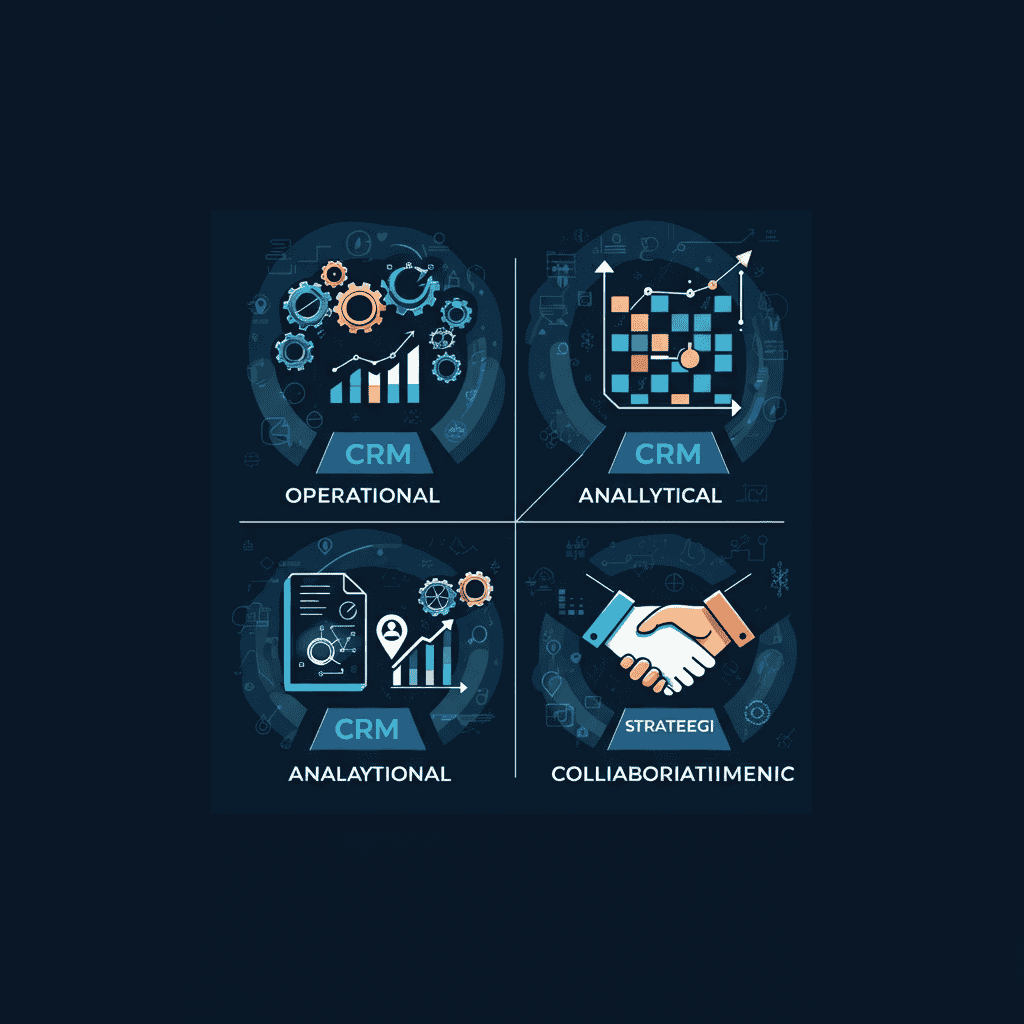Customer relationship management isn’t a one-size-fits-all approach. Different businesses have different needs, customer bases, and goals—which means they require different CRM strategies to succeed.
Understanding the 4 types of Customer Relationship Management can help you choose the right approach for your business. Whether you’re looking to streamline operations, boost sales, or create better customer experiences, selecting the correct CRM type will determine how effectively you can build and maintain customer relationships.
This guide breaks down each type of Customer Relationship Management system, explains how they work, and helps you identify which one aligns best with your business objectives.
Operational CRM: Streamlining Customer-Facing Processes in Customer Relationship Management
Operational CRM focuses on automating and improving the day-to-day processes that directly involve customers. This type of system handles the practical aspects of customer interaction across sales, marketing, and customer service departments.
The primary goal of operational CRM is to make customer-facing processes more efficient and consistent. Instead of managing customer information in scattered spreadsheets or isolated systems, operational CRM creates a centralized hub where all customer data lives.
Key Features of Operational CRM
Sales automation forms the backbone of most operational CRM systems. These platforms can track leads through the entire sales pipeline, automatically assign prospects to sales representatives, and send follow-up reminders. Many systems also generate quotes, process orders, and manage inventory levels.
Marketing automation is another crucial component. Operational CRM can segment customers based on their behavior or demographics, then automatically send targeted email campaigns, social media posts, or other marketing materials. This ensures customers receive relevant content at the right time.
Customer service automation helps support teams respond faster and more effectively. When customers contact support, the system immediately displays their complete history, previous issues, and preferences. This context allows support representatives to resolve problems more quickly and provide personalized assistance.
Best Use Cases
Operational CRM works particularly well for businesses with high customer volumes or complex sales processes. E-commerce companies, software-as-a-service providers, and retail businesses often benefit most from this approach.
Companies that struggle with inconsistent customer experiences across different touchpoints also see significant improvements with operational CRM. The system ensures that whether a customer talks to sales, marketing, or support, everyone has access to the same information.
Analytical CRM: Turning Data Into Insights
Analytical CRM transforms raw customer data into actionable business intelligence. Rather than just storing customer information, these systems analyze patterns, trends, and behaviors to help businesses make smarter decisions.
This type of CRM excels at answering complex business questions: Which customers are most likely to make repeat purchases? What marketing campaigns generate the highest return on investment? When are customers most likely to cancel their subscriptions?
How Analytical CRM Works
Data collection happens automatically as customers interact with your business. Every purchase, website visit, email open, or support ticket becomes a data point. Analytical CRM systems aggregate this information from multiple sources, including your website, social media, email campaigns, and sales interactions.
Advanced analytics tools then process this data using statistical models, machine learning algorithms, and predictive analytics. The system can identify patterns that humans might miss, such as subtle changes in customer behavior that indicate someone is likely to cancel their subscription.
Reporting and visualization features present these insights in easy-to-understand formats. Instead of sifting through raw data, managers can view interactive dashboards that highlight key metrics, trends, and recommendations.
Benefits for Business Strategy
Customer segmentation becomes far more sophisticated with analytical CRM. Instead of basic demographic categories, businesses can create segments based on purchasing behavior, engagement levels, lifetime value, or churn risk. This enables highly targeted marketing campaigns and personalized customer experiences.
Predictive analytics helps businesses anticipate future trends and customer needs. Companies can identify which products are likely to succeed, when customers might need additional services, or which marketing channels will deliver the best results.
Performance optimization occurs when businesses use analytical insights to refine their processes. Sales teams can focus on the most promising leads, marketing departments can allocate budgets to the most effective channels, and customer service can proactively address issues before they escalate.
Collaborative CRM: Connecting All Stakeholders Through Customer Relationship Management

Collaborative CRM extends Customer Relationship Management beyond your internal team to include external partners, suppliers, and even customers themselves. This approach recognizes that delivering exceptional customer experiences often requires coordination between multiple organizations.
The core philosophy behind collaborative CRM is that customer relationships are too important to manage in isolation. By sharing relevant information and coordinating efforts with partners, businesses can provide more comprehensive solutions and better service.
Key Components
Information sharing platforms allow authorized partners to access customer data, order status, and other relevant information. For example, a manufacturer might give their distributors access to inventory levels and shipping updates, enabling them to provide accurate information to end customers.
Communication tools facilitate collaboration between internal teams and external partners. These might include shared messaging systems, collaborative workspaces, or integrated communication platforms that keep everyone informed about customer issues and opportunities.
Partner portals provide external stakeholders with self-service access to the information and tools they need. Dealers might log into a portal to place orders, access marketing materials, or get product training. Customers might use portals to track orders, submit support requests, or access product documentation.
Implementation Strategies
Successful collaborative CRM requires clear agreements about data sharing, privacy, and responsibilities. Partners need to understand what information they can access, how they should use it, and what obligations they have to protect customer privacy.
Integration challenges often arise when connecting systems from different organizations. Collaborative CRM platforms need robust APIs and flexible integration capabilities to work effectively with various partner systems.
Training and adoption support become crucial when multiple organizations are involved. Everyone needs to understand how to use the collaborative tools effectively and consistently.
Strategic CRM: Aligning Customer Strategy with Business Goals
Strategic CRM focuses on the bigger picture of customer relationship management. Rather than emphasizing specific tools or processes, this approach aligns customer strategies with overall business objectives to create long-term competitive advantages.
This type of CRM recognizes that customer relationships are strategic assets that require careful planning, significant investment, and ongoing management. Strategic CRM helps businesses decide which customers to target, how to position their products and services, and what kind of relationships to build.
Strategic Planning Elements
Customer value analysis helps businesses understand which customers generate the most profit, have the highest lifetime value, or offer the greatest growth potential. This analysis goes beyond simple revenue numbers to consider factors like referral value, brand advocacy, and strategic importance.
Market segmentation strategies become more sophisticated under strategic CRM. Businesses develop detailed profiles of their ideal customers, understand what motivates different segments, and create targeted value propositions for each group.
Resource allocation decisions use customer insights to determine where to invest time, money, and attention. Strategic CRM helps businesses decide which customer segments deserve premium service, what new products to develop, and which markets to enter.
Long-term Benefits
Competitive differentiation emerges when businesses use strategic CRM to understand their customers better than competitors do. Deep customer insights enable companies to anticipate needs, deliver superior experiences, and build stronger relationships.
Customer loyalty and retention improve when businesses align their strategies with customer values and preferences. Strategic CRM helps identify what customers truly care about, then guides business decisions to deliver on those priorities.
Revenue growth accelerates as businesses focus their efforts on the most valuable opportunities. Strategic CRM prevents companies from wasting resources on low-value activities and helps them invest in relationships that drive long-term success.
Choosing the Right CRM Type for Your Business

Most successful businesses don’t rely on just one type of CRM—they combine elements from multiple approaches to create comprehensive customer relationship management strategies.
Start by assessing your current challenges and objectives. If you’re struggling with inefficient processes and inconsistent customer experiences, operational CRM should be your priority. Companies drowning in data but lacking insights will benefit most from analytical CRM capabilities.
Consider your industry and business model as well. B2B companies with complex partner networks often need collaborative CRM features, while businesses focused on long-term customer relationships should emphasize strategic CRM principles.
The most effective approach involves implementing CRM capabilities in phases. Begin with operational features to establish solid foundations, then add analytical capabilities to generate insights, incorporate collaborative elements as needed, and develop strategic frameworks to guide long-term decisions.
Remember that CRM success depends more on how you use these tools than on which specific type you choose. Focus on solving real business problems and delivering value to customers, regardless of which CRM category you’re working within.
Building Your CRM Strategy
Understanding the four types of customer relationship management gives you a framework for building more effective customer strategies. Operational CRM handles the day-to-day processes, analytical CRM provides insights and intelligence, collaborative CRM extends relationships beyond your organization, and strategic CRM aligns everything with your business goals.
The most successful companies combine elements from all four types, creating comprehensive approaches that serve customers better and drive business results. Start by identifying your biggest challenges and opportunities, then choose the CRM capabilities that will have the most impact on your specific situation.
Your customers expect consistent, personalized, and valuable experiences across all touchpoints. By selecting and implementing the right mix of CRM approaches, you can meet those expectations while building sustainable competitive advantages for your business.
Learn more about: Why Monitoring Customer Feedback is Your Business’s Secret Weapon





